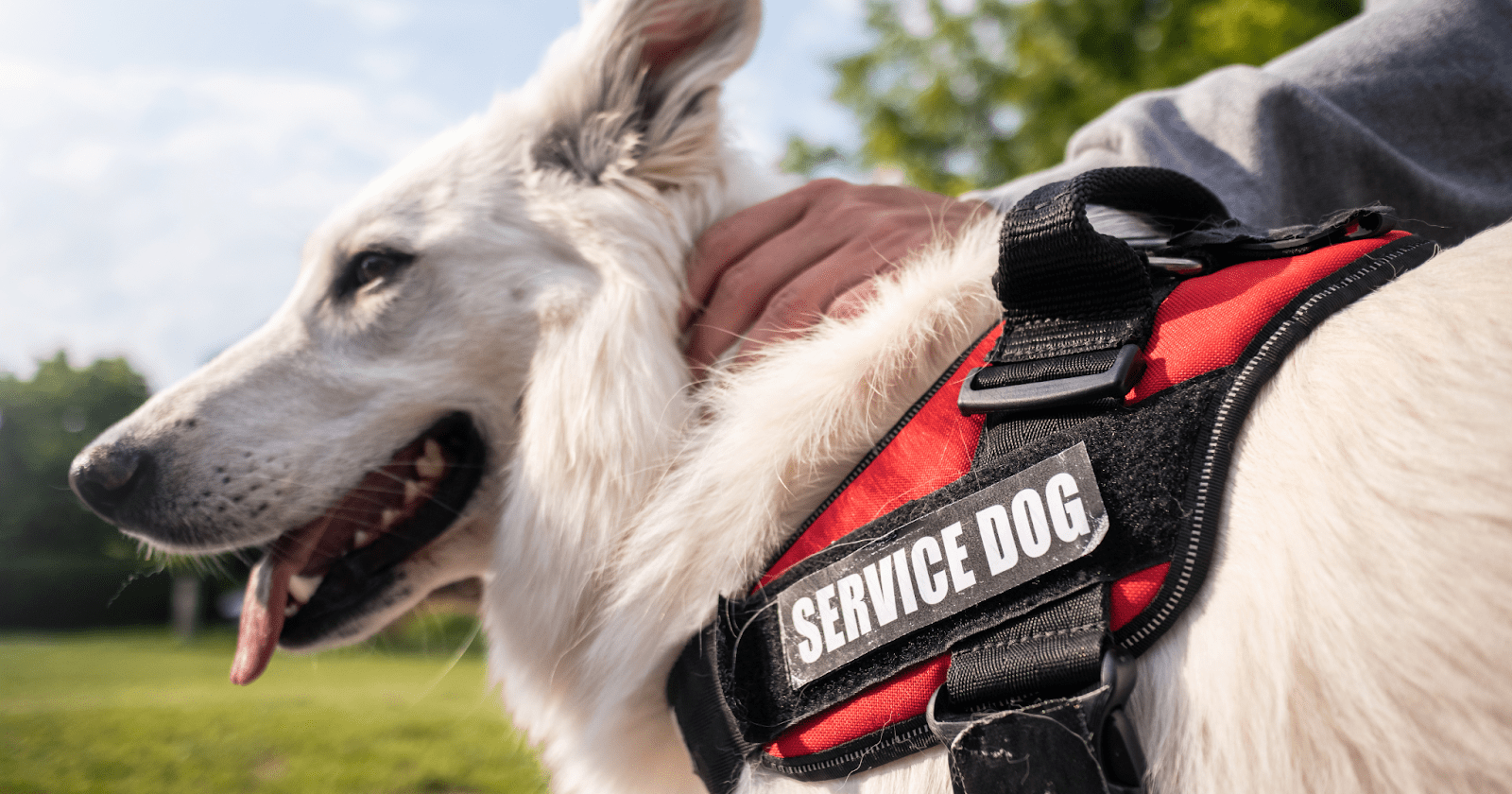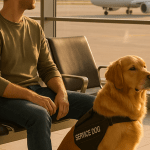Veterans living with post-traumatic stress disorder (PTSD) often return from service carrying invisible scars—memories, triggers, and emotions that can disrupt everyday life. While traditional therapies remain a critical part of recovery, many veterans have found an unexpected source of comfort and healing in emotional support animals (ESAs). These companions offer more than companionship—they create calm, reduce stress, and provide emotional stability in a way few other tools can.
It’s essential to understand the difference between an ESA and a PTSD service dog. Service dogs are highly trained to perform specific tasks, like waking a veteran during a nightmare or creating space in crowds. ESAs, on the other hand, aren’t task-trained but offer deep therapeutic benefits through their presence alone. For many veterans, the best results come from blending therapeutic interventions like CBT or EMDR with the steady, grounding presence of an emotional support animal. This article guides you through the full spectrum of options—clinical, emotional, and lifestyle-based—to help you or someone you love choose the most effective path forward.
Key Takeaways:
- Emotional support animals (ESAs) help veterans with PTSD by offering consistent emotional grounding. They can reduce anxiety, ease isolation, and support better sleep—without requiring task-specific training.
- ESAs and PTSD service dogs serve different roles. Service dogs are trained for specific tasks and have public access rights, while ESAs provide psychological comfort and are only protected under housing laws.
- Veterans must obtain a legitimate ESA letter from a licensed mental health professional. No official registry is required—just a signed recommendation confirming the animal’s therapeutic benefit.
- Combining clinical therapy with ESA support enhances recovery. Veterans often see better results when they blend structured treatments like CBT or EMDR with animal companionship.
- Holistic therapies such as mindfulness, art, and outdoor activities are more effective when paired with ESA support. The presence of an animal can make these practices feel safer and more emotionally accessible.
Clinically Proven PTSD Therapies for Veterans
Cognitive Behavioral Therapy (CBT) for Trauma
Cognitive Behavioral Therapy is one of the most researched and widely recommended treatments for PTSD. It focuses on identifying and reshaping the negative thought patterns that stem from trauma. For veterans, CBT can help reduce avoidance behaviors, challenge guilt or shame-based thinking, and build healthier coping strategies for daily stress.
- Available through most Department of Veterans Affairs (VA) facilities
- Often part of structured PTSD recovery programs
- Especially effective when combined with emotional support tools like ESAs
Eye Movement Desensitization and Reprocessing (EMDR)
EMDR is a unique, evidence-based therapy that uses guided eye movements or other bilateral stimulation to process traumatic memories. It’s been shown to reduce the emotional charge associated with trauma and is endorsed by both the Department of Veterans Affairs and the Department of Defense.
- Non-invasive, no need to “relive” trauma verbally
- Can work well for combat-related and non-combat PTSD
- Often used in conjunction with ESAs to manage emotional spikes after sessions
Cognitive Processing Therapy (CPT)
CPT focuses on helping veterans examine and reframe their thoughts about the trauma. It helps break cycles of guilt, self-blame, and persistent negative beliefs that interfere with recovery.
- Often part of VA intensive outpatient programs
- Especially useful for processing moral injury or military sexual trauma
- Benefits from outside-the-clinic support like peer groups or animal companionship
Prolonged Exposure Therapy
This therapy encourages veterans to gradually and safely revisit memories or situations they’ve been avoiding. The goal is to reduce fear responses by confronting, rather than escaping, triggers.
- Requires commitment and emotional readiness
- Can be mentally and physically exhausting
- A good candidate for pairing with ESAs, who offer post-session emotional grounding
Emotional Support Animals and PTSD: What to Know

What Is an ESA and How It Differs from a Service Dog
An emotional support animal is a companion—often a dog or cat—who provides psychological comfort through their presence. Unlike service dogs, ESAs don’t undergo specific task training and aren’t guaranteed public access.
ESA vs PTSD Service Dog – Key Differences:
| Feature | ESA | PTSD Service Dog |
| Training Required | None | Yes, task-specific |
| Legal Protection | Housing rights (FHA) | Full access (ADA, Air Carrier Access Act) |
| Role | Emotional support | Task-based assistance |
| Certification Needed | ESA letter from a therapist | Training and certification required |
| Public Access | No general access rights | Permitted in public places |
How ESAs Help with PTSD
Though not task-trained, ESAs play a significant emotional role in a veteran’s healing process. Their benefits include:
- Providing a sense of calm during flashbacks or anxiety
- Easing isolation and helping with emotional regulation
- Encouraging routines, physical activity, and responsibility
- Supporting sleep quality and reducing panic
Many veterans describe their ESA as a “safety anchor”—someone to lean on when human interaction feels overwhelming.
Who Qualifies for an ESA for PTSD
Veterans with a documented diagnosis of PTSD can qualify for an ESA by obtaining a letter from a licensed mental health professional. The letter should confirm that the animal helps manage symptoms such as anxiety, panic attacks, or depression.
- An ESA letter is not a prescription—it’s a formal mental health recommendation
- Only valid when written by a therapist, psychologist, or psychiatrist
- Not required to register your animal online—registries are often scams
While ESAs are not recognized as service animals under the ADA, they are protected under the Fair Housing Act, which means landlords must make reasonable accommodations, even in no-pet housing.
PTSD Service Dogs: Trained Companions for Daily Functioning

Tasks PTSD Service Dogs Can Perform
Unlike ESAs, service dogs for PTSD undergo specialized training to perform tasks that mitigate specific symptoms, such as:
- Waking a veteran during a nightmare or night terror
- Nudging or grounding during a flashback
- Creating space in public settings
- Alerting to rising anxiety or panic
- Retrieving medication or leading the veteran to safety
These dogs are legally recognized as working animals under the ADA, meaning they’re allowed in most public places, including restaurants, buses, airports, and more.
How to Get a PTSD Service Dog as a Veteran
Organizations such as K9s for Warriors, Paws for Purple Hearts, and Patriot Paws provide specially trained service dogs at no cost to qualified veterans. While there’s often a waitlist and an in-depth application process, these programs ensure that both the veteran and dog are well matched.
- Some require on-site training and bonding time
- Waitlists can be 6–18 months
- Dogs are trained for both physical and psychological support
VA Considerations and Legislation
Currently, the VA does not cover the cost of service dog training for PTSD-only cases. However:
- They may cover veterinary care for service dogs trained for physical disabilities
- There is ongoing advocacy for legislation like the PAWS Act, which supports expanding coverage for PTSD service dogs
Lifestyle-Based and Alternative Support Options for PTSD
Therapeutic Outdoor Activities
- Nature therapy, gardening, walking an ESA
- Shown to lower cortisol and promote calm
- Strengthens the human-animal bond in open, restorative environments
Yoga and Mindfulness Practices
- Breathing regulation improves nervous system function
- Veterans report better control over anger and anxiety
- Often available through VA-sponsored wellness groups
Art and Music Therapy
- Builds emotional resilience and new communication pathways
- Safe space to express internal struggles
- Can be used alongside ESA support for creative regulation
Peer Support and Veteran Community Programs
- Sharing stories with others who understand the experience of PTSD
- Reduces shame and builds accountability
- Many peer groups now include animal-assisted gatherings or therapy dog visits
Blending Therapy with Animal Support
There is no one-size-fits-all solution when it comes to managing PTSD. Some veterans thrive with structured therapy alone, while others benefit from a more integrated, lifestyle-focused plan. When deciding what support to seek, consider:
- Severity of PTSD symptoms
- Comfort with clinical vs. alternative treatments
- Housing situation and daily lifestyle needs
- Access to funding and therapy networks
Integrated Care in Practice
Examples of effective combinations:
- CBT sessions paired with ESA companionship during off-days
- EMDR therapy with a PTSD service dog providing grounding during stressful transitions
- Art therapy supported by the emotional regulation an ESA provides at home
Ultimately, the best approach is one that helps you feel safe, supported, and empowered to heal at your own pace.
Common Misconceptions About PTSD Treatment and ESAs
- “Only service dogs help with PTSD.”
False. ESAs provide a different kind of support—emotional regulation, comfort, and companionship—that many veterans prefer.
- “PTSD always requires medication.”
Not true. Many veterans manage symptoms through therapy, peer support, and alternative practices like yoga and animal companionship.
- “You can bring your ESA anywhere.”
ESAs are only protected in housing and airline (some limitations) settings, not restaurants, stores, or public transit.
- “ESAs aren’t real medical help.”
Research shows animal companionship can lower blood pressure, improve mood, and ease symptoms of anxiety and trauma.
Support That Listens, Heals, and Stays by Your Side
Healing from PTSD isn’t about following a fixed protocol—it’s about discovering what brings you calm, safety, and stability in the moments that matter most. For veterans, that might mean structured therapy, the trained reassurance of a service dog, or the quiet companionship of an emotional support animal. Each path offers its own kind of relief—and often, the most effective care involves a thoughtful blend of all three.
At Emma & Buddy, we’re here to simplify that journey. Our team connects you with licensed professionals who understand the emotional weight of PTSD and the role an ESA can play in daily recovery. With interest-free payment plans, fast approvals, and a streamlined process, we make it easy to get the official documentation you need—so you can focus on creating a support system that works for your life, your pace, and your peace of mind.
FAQ: Emotional Support Animals and PTSD
Can emotional support animals really help with PTSD?
Yes. Emotional support animals (ESAs) offer deep, consistent emotional grounding for veterans living with PTSD. Their presence can lower stress levels, calm the nervous system during anxiety spikes, and provide a sense of safety that’s hard to replicate with traditional methods alone. For many veterans, ESAs help reduce symptoms such as hypervigilance, flashbacks, emotional isolation, and disrupted sleep. The simple act of petting a dog or cat can regulate breathing and trigger oxytocin release—contributing to mood stabilization and emotional resilience. When combined with outdoor activities like walking, hiking, or gardening, ESA companionship becomes a powerful part of holistic PTSD support.
What’s the difference between a PTSD service dog and an emotional support animal (ESA)?
The key difference lies in training and legal status. A PTSD service dog is specially trained to perform specific tasks that directly assist with a veteran’s disability—such as waking them from nightmares, guiding them to safety during an anxiety attack, or creating physical space in crowds. These dogs are recognized under the Americans with Disabilities Act (ADA) and have full public access rights.
In contrast, an emotional support animal offers therapeutic benefit simply through their presence. ESAs do not require specialized training and are not permitted in all public places. However, they are protected under the Fair Housing Act (FHA), meaning landlords must make reasonable accommodations even in no-pet housing. While both support mental health, their roles, protections, and daily responsibilities differ significantly.
Are emotional support animals covered by the VA?
No. At this time, emotional support animals are not covered by the Department of Veterans Affairs. The VA does not provide funding for ESA acquisition, training, or care—even for veterans with PTSD. However, the VA may provide limited support for service dogs trained for physical disabilities, such as mobility assistance.
That said, many nonprofit organizations offer grants, scholarships, or reduced-cost animal services for veterans. Veterans pursuing ESA support should also budget for long-term care, including veterinary visits, vaccinations, pet food, and emergency expenses.
What are the best holistic or alternative therapies for PTSD—and how can ESAs complement them?
Some of the most effective holistic and alternative PTSD therapies include:
- Yoga and meditation to regulate the nervous system
- Art and music therapy to express and process trauma
- Peer support groups to share experiences and reduce isolation
- Nature therapy through hiking, forest bathing, or gardening
- Acupuncture and massage therapy to release somatic tension
Emotional support animals naturally integrate with these therapies. A dog may walk beside you during morning mindfulness or keep you grounded during difficult group conversations. The combination of movement, fresh air, and nonverbal connection can gently ease PTSD symptoms and encourage emotional resilience.
How do I get an ESA letter for PTSD?
To qualify for an emotional support animal, you need a written recommendation (commonly referred to as an ESA letter) from a licensed mental health professional—such as a psychologist, psychiatrist, therapist (LCSW), or clinical counselor. The letter must state that you have a mental or emotional disability (such as PTSD) and that the presence of the animal helps alleviate at least one symptom of that condition.
It’s important to avoid ESA “registries” or online scams. You do not need to register your animal in a national database. The only legal requirement is a valid ESA letter on professional letterhead, signed and dated by a licensed provider in your state.
What responsibilities come with having an ESA as a veteran with PTSD?
Owning an ESA means taking on full responsibility for the animal’s health, behavior, and well-being. Veterans should be prepared to:
- Provide daily care: feeding, walking, grooming, exercise, and affection
- Maintain regular veterinary visits for vaccinations, checkups, and dental care
- Ensure proper nutrition with a balanced, age-appropriate diet (especially for dogs or cats with special needs)
- Cover costs: food, bedding, leashes, medications, and potentially pet insurance
- Respect boundaries: ESAs do not have public access rights like service dogs, so owners must follow rules in public and private spaces
While ESAs are not required to perform tasks, they still rely on responsible, consistent care. A strong ESA-veteran bond is built on trust, routine, and mutual respect.













